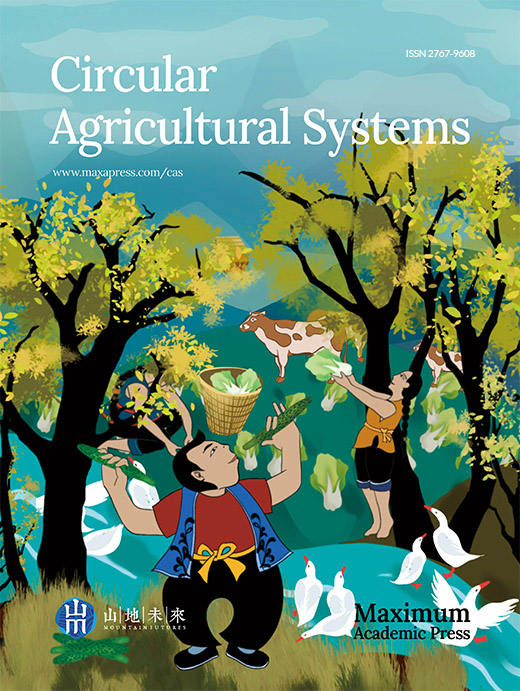-
The challenges of replicating or scaling up models and heuristics of circular economies in a complex, interconnected world are immense, and suggest the need for systemic transformational change[1]. Many of the responses to these challenges have focused on identifying and studying the necessary elements of a circular system, in other words, gathering more data.
Transformational change, however, does not necessarily require more data, but rather new ways of understanding the evidence we already have. In the words of Nobel-prize winning microbiologist Joshua Lederberg, "Biology is already so fact-laden that it is in danger of being bogged down awaiting advances in logic and linguistics to reach the integration of the particulars."[2]. Post-Normal Science offers a different way to approach the evidence we have, and to open up new possibilities for research and application.
-
If circular agricultural systems (CAS) are approached as one larger problem within which many others are nested, then it becomes apparent that this problem is a type of what sociologists have called "wicked problems"[3]. Wicked problems are often poorly defined, within which contradictory forces prevent straightforward solutions. Improvements in some fields, such as agricultural production, may have unexpected consequences elsewhere, accumulating and magnifying over time. Undesirable consequences emerge from ways in which humanity has solved earlier problems. For instance, industrialization, basic scientific research, and technical advances combined with economies of scale to solve problems of hunger; nevertheless, the methods used to solve food shortages are now associated with environmental degradation, panzootics, and pandemics[4].
How can scientists, particularly applied scientists looking for ways to close the circles in agriculture and to minimize deleterious side effects, best respond to this? We often hear admonitions that policy-makers should "follow the science". This assumes that there is one kind of science, and that all science converges on a global truth. If we follow "the science", this argument goes, we will know the truth, and then we (and hence the decision-makers who follow us) will know what to do.
According to the philosopher of science Thomas Kuhn[5], normal science is a form of puzzle-solving. Many practicing scientists will recognize this as the day-to-day research that they conduct. They are filling in the gaps in scientific knowledge that are found within the dominant paradigm. Normal science does not question or challenge the underlying assumptions of that paradigm. Each of us, as scientists, have been taught the rules of our disciplines, and have been judged by our peers based on how well we have followed those rules. If we come across data that don't fit, we treat them as anomalies. If enough anomalies accumulate, the science goes through a revolutionary period in which a new paradigm is created that hopefully explains the anomalies.
This view of science has been able to deliver an incredible variety of technical insights. In this highly-focused science, our work is judged by our disciplinary peers and its quality is judged according to clear methodological rules. In a pandemic, this work can identify viral structures and produce remarkable vaccines in a short time. In the context of circular agricultural systems, this work might focus on the movement of specific nutrients or toxins in specific soil types. Normal science works best—in fact I would argue that it only works—if those practicing it can focus down on very narrowly defined specific questions, where answers can be clear.
But what of the larger, more "wicked" problem of sustainable agri-food systems, which is the one we all aspire to solve? Normal science becomes more problematic in applied situations, where the challenges of decision-making influence the types of questions we ask. In the sciences related to professional consultancies (such as in my own work as a veterinary epidemiologist) the questions we ask are determined together with our clients, and because uncertainties abound, we make judgement calls based on probabilities and prior histories. In this case, the stakes may be quite high—the death of some animals, the loss of crops, or the bankruptcy of a farm—but the involvement of clients enables us to draw on a broader assessment of evidence, including experiential and local knowledge of farmers, as well as laboratory and field experimental work. These clients become our peripheral vision, seeing things that we, as experts in a particular discipline, have been trained to block out in the interests of maintaining focus.
Research into circular agriculture in the setting of an experimental centre makes use of some combination of normal laboratory and applied sciences, but does so within a systemic understanding of the context. Systems scientists and theorists have attempted to address questions related to complex social and cultural interactions through building theoretical and mathematical models. Initially, such models might be quite simple; two examples are the social-ecological models proposed by ecological engineer James Kay[6], and the four-box "lazy-eight" diagram used by the Resilience Alliance, which is similar to the notion of creative destruction in which systems go through phases of exploitation, conservation, release and reorganization[7]. Both models are heuristics that demonstrate how social forces change landscapes and how those changed landscapes then change social forces. Both these models can work very well within a closed, bounded system.
Many conventional farms function in a recurrent pattern which involves planting new seeds (in anticipation of prices and markets), killing all the plants and animals they don't like or need (weeds, pests and sick animals), growing a new crop (conservation), harvesting the mature crop (which ecologically is a sort of destruction), and finally, restructuring and renewing the fields with seeds of the plants or young animals (reorganization).
Under assumptions of closed systems, such models can provide important insights. However, we should never confuse our models, which are after all simplifications based on selected variables, with the complexity of the real world.
The world we live in can be described as a series of nested hierarchies. As an individual, I have physical and social boundaries and an internal set of rules by which I function. I am also a member of a family with rules and boundaries, which is a member of various communities, each with its own rules and boundaries. By virtue of the fact that I eat, drink, perspire, breathe, urinate, and defecate, I can also be described according to my membership in several nested ecological and infrastructure systems related to manure, water, and nutrient recycling, extending from households and communities to global trading systems and climate change. Similarly, plants and animals in a particular landscape and micro-climate are nested within layers of larger landscapes, biomes, and climatic zones, as well as within various social and political systems.
When the Kay or Resilience models are expanded to account for this nesting, the modeling becomes considerably more complex and unwieldy. This complexity increases in a time when the climatic and environmental baselines are shifting (there is no normal to which we can return) and the boundaries of our systems have not only been enlarged regionally and globally, but have also, in some sense, gone "feral." That is, the boundaries of the issues related to inputs and outputs change frequently, depending on the specific variable we are considering (nitrogen, water, markets) and according to political, economic, demographic and climatic changes. What has become apparent during the COVID-19 pandemic is that our models often depend upon assumptions of stable baselines and boundaries. There is not a single scientific model that can encompass all the relevant variables, and making the models more complex does not solve this problem. It seems as if we then are approaching the limits of what normal and systems sciences can offer.
Post-Normal Science (PNS) was designed to address many of these issues[8] and as Peter Gluckman, New Zealand's chief science adviser, has argued, is especially important when we are doing "science for policy"[9]. Resisting disciplinary sciences' tendency to work in silos, PNS wants disciplinary experts to work side by side with stakeholders in extended peer communities.
PNS was initially designed to address societal, issue-driven questions relating to environmental debates, where, typically, facts are uncertain, values in dispute, stakes high, and decisions urgent. Here, the people with whom we are seeking answers are part of an extended peer community, working together with experts and scientists in a process of reciprocal learning and together defining the questions and evaluating answers. This extended peer community includes representatives of all those who have a stake in the questions being asked and/or have knowledge that is outside the usual scientific community. For circular agricultural systems, these extended peers will vary from place to place according to the questions asked; they will include the usual scientists, agronomists and decision-makers of course, but if we aspire to create a globally sustainable system, then stakeholders will include indigenous people and others with local understanding of the landscape[10−12]; furthermore, one of the lessons of the SARS-CoV-2 pandemic is that we should be paying attention to the interactive dynamics of other species and how they relate to cultural and historical trends[13−15].
Members of this extended peer community serve as peripheral vision for each of us, enabling us to detect the movements of important variables outside our usual focus, constraining and orienting the whole community of scholars and practitioners as we move, collectively, toward resolving conflicts in the midst of our "wicked" problems.
Many of us, trained in normal science and professional consultancy, have had some trepidation working within a scientific process that attempts to accommodate the chaotic cross-currents and strong opinions of these "extended peer communities", who deploy "extended facts" and take an active part in the solution of their problems.
The challenges of assuring quality control for post-normal scientists are an order of magnitude greater than what we have faced within the disciplines of normal science. PNS pushes us to examine not only all the technical complexities of our work, but also what our assumptions and values are. Why are we doing this work? Among the many competing goals, what really matters? This is difficult, and may generate conflicts; as scientists, we should welcome these conflicts as opportunities to learn from each other, and from the human communities we serve. Still, if we are interested in grappling with the big, interacting, questions of the day such as circular economies, agricultural sustainability, biodiversity, climate change, pandemics, food safety, food security and One Health, this is the landscape into which we must venture.
-
The authors declare that they have no conflict of interest.
- Copyright: © 2022 by the author(s). Published by Maximum Academic Press, Fayetteville, GA. This article is an open access article distributed under Creative Commons Attribution License (CC BY 4.0), visithttps://creativecommons.org/licenses/by/4.0/.
-
About this article
Cite this article
Waltner-Toews D. 2022. Circular Agriculture and Post-Normal Science. Circular Agricultural Systems 2:1 doi: 10.48130/CAS-2022-0001
Circular Agriculture and Post-Normal Science
- Received: 15 February 2022
- Accepted: 02 March 2022
- Published online: 29 March 2022
Abstract: Theories of circular economies are aspirational, taking ideas from ecology and using them to guide human practice to promote sustainability. While many of the specific elements necessary to create such systems have been identified, most examples of applying these ideas have been at farm or, at most, regional scales. Normal science has been extraordinarily successful in describing in detail many of the necessary components in this work, but seems ill-equipped to grapple with and understand the complex, multi-layered, social and ecological context within which these details interact. Post-Normal Science offers a way to re-imagine the problem and begin the important process of understanding these interactions to promote transformational change.
-
Key words:
- Ecology /
- Normal science /
- Regional scales /
- Global scales /
- Sustainability












